If you’re looking for a poultry breed with unique and striking features, look no further than the Ayam Cemani. This breed originated from Indonesia, known for its all-black feathers with a metallic sheen, beak, and even black internal organs, caused by a dominant gene that results in excess pigmentation.
The Ayam Cemanis are beautiful chickens and have been prized for centuries for their mystical and religious purposes in their homeland. This breed was first discovered by Dutch settlers who colonized the region, but it wasn’t imported to Europe until 1998. This timing makes it one of the most modern “Western” breeds.
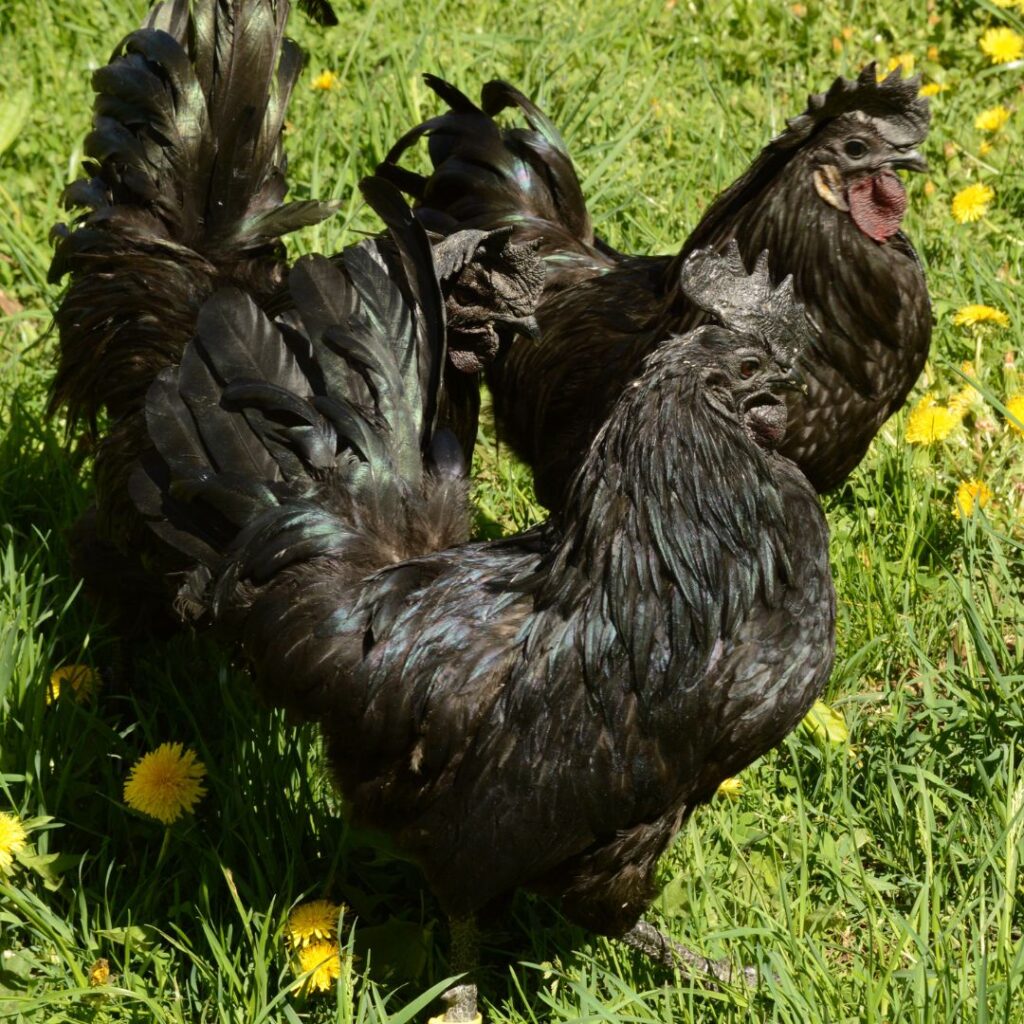
Despite its recent introduction to the Western world, the Ayam Cemani has gained a dedicated following of poultry enthusiasts who appreciate its unique appearance and fascinating history.
The History of The Ayam Cemani
Ayam Cemani, a fascinating and exotic chicken, has its roots in Indonesia. Its origin can be traced to the island of Java (Ayam Bekisar chicken) , and it is also associated with the Ayam Kedu, a group of chicken breeds from the central plains of Java. Some sources believe that Ayam Cemani may have even originated in Sumatra, where the original breed is now extinct.
During the 12th century, these unique chickens were primarily used for religious and mystical purposes. Their striking appearance caught the attention of Dutch colonial settlers, who documented the breed in the 1920s. This bird’s international journey began in the 1990s when a Dutch breeder, Jan Steverink, imported them to Europe, specifically the Netherlands and Sweden.
In addition to Java and Sumatra, Ayam Cemani can also be found on the island of Bali. This fowl’s unique features and characteristics have piqued the interest of chicken enthusiasts worldwide, including in the United States. American chicken keepers eagerly await the day the American Poultry Association (APA) recognizes this extraordinary bird.
Here’s a brief overview of Ayam Cemani’s intriguing heritage:
- Origin: Java, Indonesia
- Associated with: Kedu breeds
- Possible extinct origin: Sumatra
- Documented by: Dutch colonial settlers in the 1920s
- Imported to Europe: 1998 by Jan Steverink
- Present in countries such as the Netherlands, Sweden, and the United States
- Name Origin: The word Ayam means chicken in Indonesian; Cemani: two possible translations = entirely black, or a place called Cemani in Java.
As an enthusiast, you can contribute to preserving and promoting this rare and captivating chicken.
The Ayam Cemani; Standard and Appearance
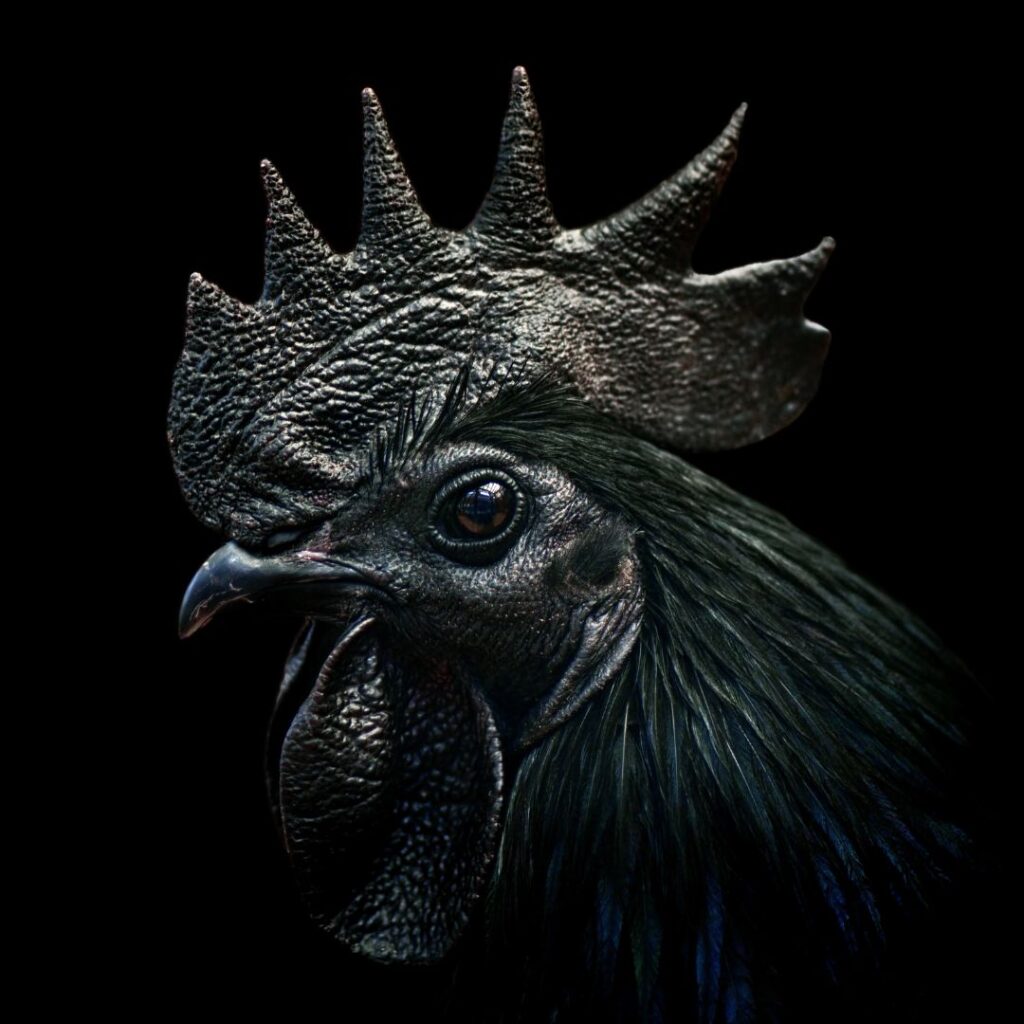
As you explore Ayam Cemani’s world, you’ll realize how unique and captivating these birds genuinely are. Not only are their hyperpigmented skin, feathers, and organs intriguing, but their overall appearance and character can captivate any avian aficionado.
Adult rooster average weight is around 4.5-6.5 pounds, and hen’s weight is between 3.5-4.5 pounds. Even with their medium frame, Ayam Cemanis have a strong, muscular build that contributes to their game-like appearance.
Color and Black Pigment
Ayam Cemani is a fascinating black chicken known for its unique appearance, mainly due to fibromelanosis, which causes dermal hyperpigmentation. This genetic condition leads to an excess black pigment, making the bird’s skin, organs, and bones black or dark gray. Their blood, however, retains a normal color. The Ayam Cemani is one of the few black fowls with this striking appearance.
Comb, Wattles, and Beak
With its black skin comes the black coloring of the comb, wattles, beak, and tongue. You’ll notice that the Ayam Cemani’s comb and wattles are slightly different from those of other chickens. Even their beak and tongue have a distinct black or dark gray coloring, completing an overall solid black appearance.
Feathers and Iridescent Sheen

Although their feathers may also appear entirely black at first glance, Ayam Cemanis are known for having a green and purple iridescent sheen. Their close-fitting black feathering show a mesmerizing greenish-blue tinge when under sunlight or proper lighting. This sheen gives the bird an even more exotic and visually striking appearance, described as a beetle green with purple iridescence.
Do Ayam Cemani Baby Chicks Have Black Feathers?
When you first look at Ayam Cemani chicks, you’ll be surprised that they’re unlike any other chicks you’ve seen. These adorable babies are jet-black from head to toe, thanks to a dominant gene called fibromelanosis. This rare genetic trait makes these chicks stand out in any flock, and you’re sure to fall in love with their unique appearance.
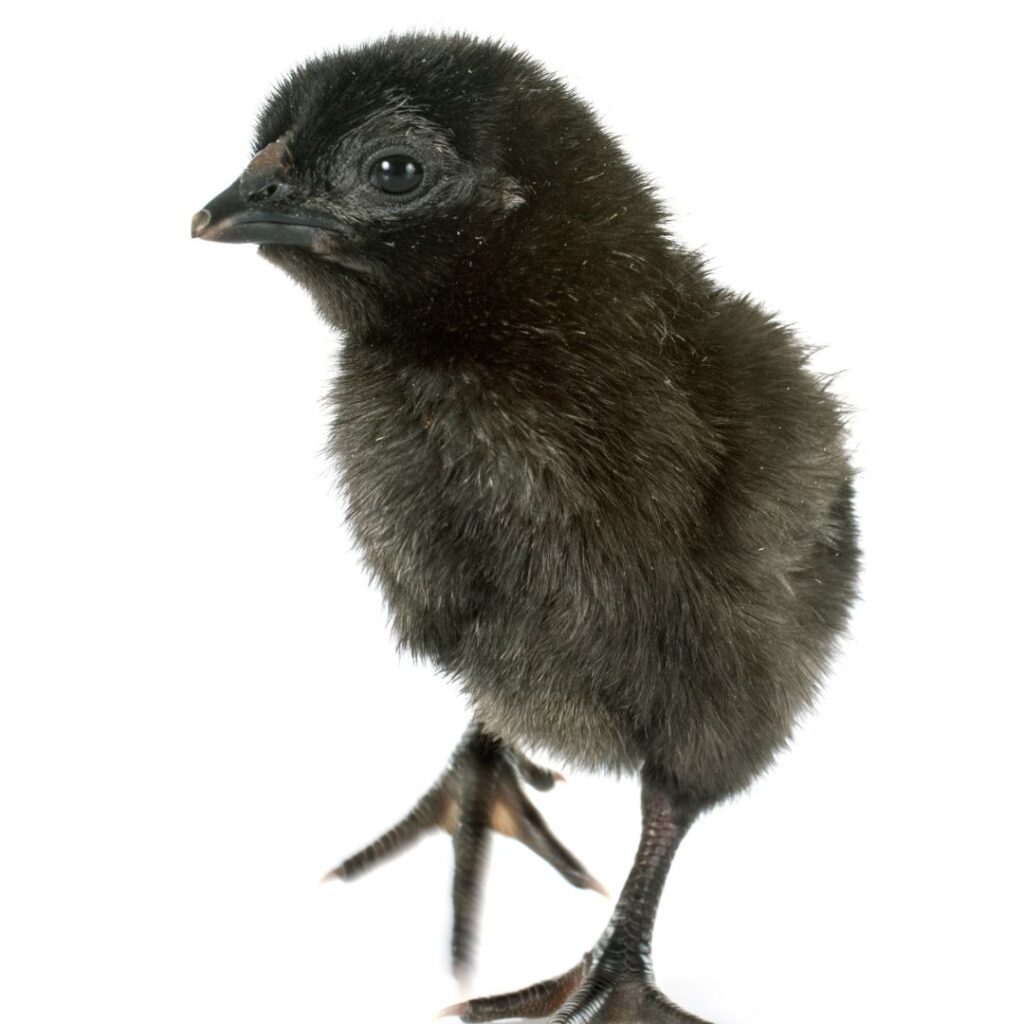
As your baby Ayam Cemanis grows, you’ll notice its feathers developing a beautiful iridescent sheen. Their all-black feathering will shimmer in sunlight with beautiful green and blue hues, almost like they reflect the colors of a beetle’s wings.
Ayam Cemani chicks hatch from unusually large eggs considering they grow up to be medium-sized birds.
Here are some features of Ayam Cemani chicks to watch for as they grow:
- Jet-black feathers, skin, and organs
- Black comb, Black Wattle, Black legs, even black tongue
- Iridescent green and blue sheen in the sunlight
- Medium frame and muscular build as they mature
- Game-like posture with an alert and upright stance
Remember to provide adequate care and nutrition for your chicks. As they grow, you’ll undoubtedly appreciate the beauty and uniqueness this extraordinary fowl brings to your flock.
Personality Of An Ayam Cemani Chicken
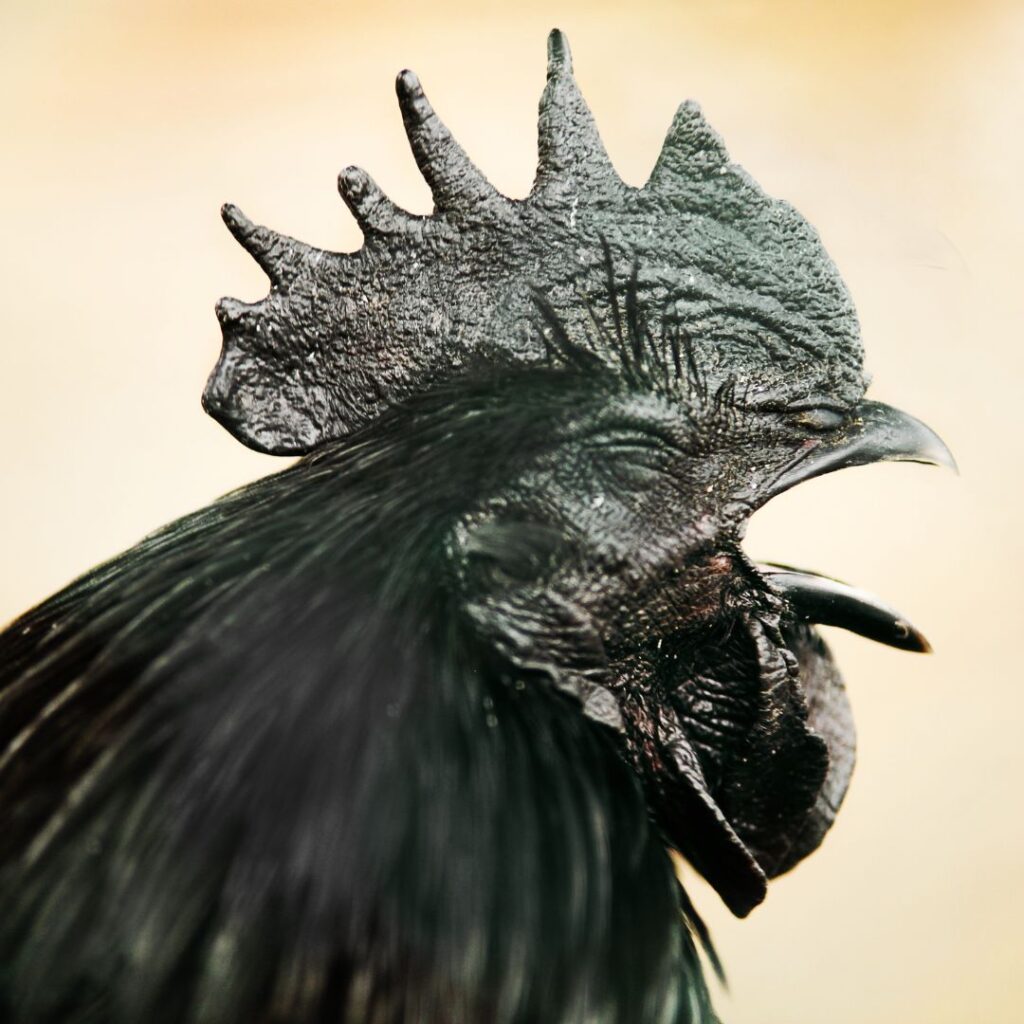
Ayam Cemani are known to be friendly birds and easy to handle, although not known as a lap chicken. These qualities make them a popular bird for those looking for pet or ornamental poultry. They tend to be docile and make great flock mates.
Are Ayam Cemani Roosters Aggressive?
Ayam Cemani roosters are generally known for being gentle and docile, which is quite surprising considering their striking appearance. You’ll find that they’re intelligent and easy to handle, making them suitable for experienced chicken keepers and beginners alike. Even though they may seem intimidating, Ayam Cemani roosters aren’t typically aggressive toward humans or other chickens. Their confident yet calm demeanor allows them to coexist peacefully within a flock.
Fun Fact: They have a very distinct crow used as a foghorn in the native country.
Are Ayam Cemani Hens Broody?
As for the females, the Ayam Cemanis aren’t overly broody. However, broodiness can still occur under certain circumstances. Being part of a rare breed, these birds exhibit unique characteristics that make them desirable for their beauty and strong black bones, and tissues, yet they are poor setters, making them less likely to hatching eggs from their own brood.
If you have a fertilized egg, these females rarely hatch their own. You can put it with another female that is more broody.
- Ayam Cemani roosters are gentle, docile, and intelligent.
- Roosters are not overly aggressive.
- Hens aren’t typically broody, but keep an eye on their behavior in case you get the occasional hen that wants to be hatching eggs.
- This rare breed has strong health characteristics and excellent foraging abilities.
So, if you’re looking for stunning black chickens and easy to care for, Ayam Cemani may be the perfect breed for you.
Ayam Cemani Egg Laying

When raising Ayam Cemani hens, it’s essential to be aware of the Ayan Cemani egg capabilities. This fowl is not known for being a prolific layer. You can expect your Ayam Cemani hens to lay about 80 eggs yearly.
Your hen’s laying cycle might be different from other chicken types. Typically, an Ayam Cemani hen will lay 20 to 30 eggs and then take a break for an extended period, sometimes up to six months. After this break, they will resume laying, and the cycle will continue.
The Ayam Cemani eggs are considered unique in a few ways. Firstly, the Ayam Cemani egg color tends to be cream-colored, unlike the white or brown color produced by many other breeds. Further, these eggs are unusually large in proportion considering the size of the hen.
Here’s a quick overview:
- Average of 80 eggs per year.
- Typical laying cycle lasts: 20 to 30 eggs, followed by a break of up to six months.
- Cream-colored egg (sorry, not black eggs).
- Unusually large egg size in relation to their body size.
Your hens will not be heavy layers, and laying cycles might differ from other breeds. However, the unique characteristics of their cream colored eggs can make them a fascinating addition to your poultry collection.
Meat Birds; dual purpose bird with black meat
When considering if the Ayam Cemani chicken is suitable as a dual-purpose chicken, you should know that these chickens differ from your typical meat birds.
Unlike popular meat chicken breeds like Cornish Cross, Ayam Cemanis are known for their unique appearance and characteristics rather than their meat and eggs.
Ayam Cemanis have an all-black pigment, making them visually striking. Their black feathers, skin, and internal organs are due to the fibro melanistic gene.
While this makes them an interesting choice aesthetically, there may be better options for meat production.
Their meat is similar to other chickens in terms of taste and texture. However, be aware that the color of their meat is much darker than usual.
To quickly compare the Ayam Cemani chicken with other popular meat and dual-purpose birds, consider the following:
- Ayam Cemani: Unique all-black coloration, moderate egg production, smaller carcass size
- Cornish Cross: Fast growth, excellent meat quality, heavyweight, not ideal for egg production
- Plymouth Rock: Good meat production, reliable egg layers, cold-hardy, friendly temperament (Barred Plymouth Rock)
Are Ayam Cemani Cold Hardy? Heat Tolerant?
Ayam Cemanis can tolerate various weather conditions. Though they might not be cold-hardy birds, they can manage in colder climates with proper care and coop preparation.
Similarly, they can tolerate heat as long as they can access shade and water.
The Chicken Coop Needs for The Ayam Cemani Chicken
Please consider their coop requirements to ensure your Ayam Cemanis are comfortable and safe. Here are some guidelines:
- Space: Provide at least 2-3 square feet per bird inside the coop.
- Ventilation: Proper airflow is essential to keep your chickens healthy
- Roosting area: Allow at least 8-10 inches per bird for roosting space
- Nesting boxes: Provide one nesting box for every 4-5 hens to lay their eggs comfortably
- Feeders and waterers: Elevate these a few inches off the floor to help keep litter out
The Chicken Run For Your Ayam Cemani Chicken
In addition to the coop, your Ayam Cemani flock will enjoy a spacious chicken run to explore and exercise. Consider the following when designing their run:
- Space: Allocate at least 10 square feet of run space per bird.
- Fencing: Install a sturdy fence to protect your flock from predators and keep them confined.
- Natural elements: Include some bushes, shrubs, or trees in the run for them to investigate and perch on.
- Dust Bath: Keeping a dust bath will help your flock stay looking iridescent as well as help free them of lice and mites, not to mention it’s an excellent way for them to cool off.
Free-Range and Foraging; Ayam Cemani Chickens
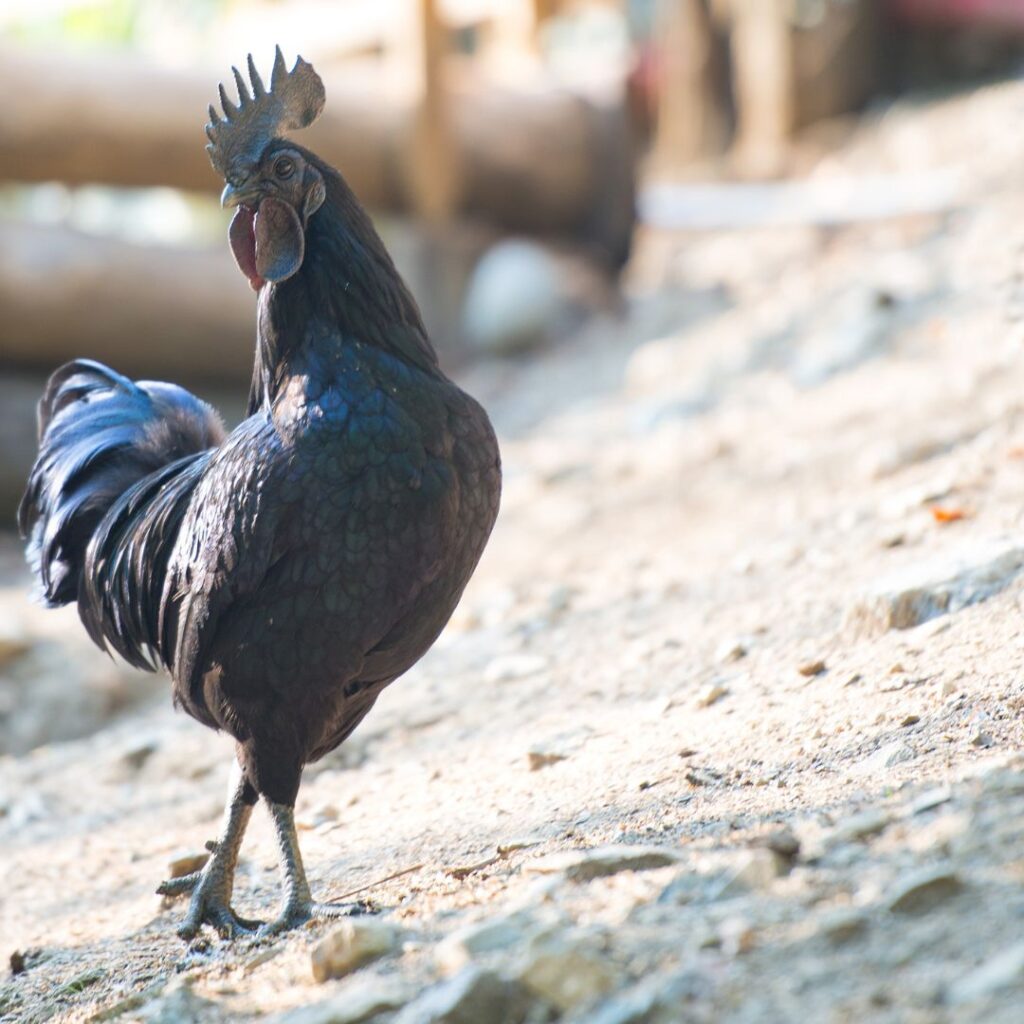
Ayam Cemanis are a unique and fascinating breed known for their jet-black coloration. Considering raising this breed in a free-ranging environment, you may wonder how well Ayam Cemani adapts to foraging and free-ranging.
Ayam Cemani are known to be active foragers. In a free-range setting, you’ll find them actively seeking out insects like ticks, seeds, and other natural sources of food (think weed control!) . This foraging behavior can help keep your chickens healthy while reducing feed costs.
When setting up your free-range area, provide ample space for your Ayam Cemani chickens to roam and search for food. Here are some tips to for planning the run area:
- Enclosing the run with secure or temporary fencing to protect your chickens from predators.
- Providing clean, fresh water for your birds to drink.
- Offering a shaded area for your chickens to rest and escape the heat.
Are the Ayam Cemani Good Urban (City) Chickens?

As you contemplate whether the Ayam Cemani is suited for urban settings, you must consider several factors. Let’s examine some of the primary concerns that could influence your decision.
Noisy?
You might wonder if Ayam Cemanis are noisy, which could be a problem in a closely-spaced urban environment. Thankfully, this breed is generally known to be quieter than other chickens, producing fewer loud noises that might bother your neighbors. The Ayam Cemani roosters’ crow is relatively lower in volume than other roosters, making them more appropriate for urban settings.
Space Requirements
As a medium-sized bird, the Ayam Cemani chicken requires adequate space to roam and thrive. Their ideal environment includes a spacious coop and access to a secure outdoor space where they can forage and exercise. In an urban (city) setting, you may need to be creative to provide enough space for them within the confines of your city property.
- Coop size: Ideally, provide 3 to 5 square feet per bird
- Outdoor space: Aim for 8 to 10 square feet per bird
- Outdoor shelter for shade and protection from the elements
- Space for a dust bath
Social Needs
Ayam Cemanis is an intelligent and friendly breed, so meeting their social needs is essential to ensure their happiness. If you have the space for housing a small flock, your chickens will likely thrive better than if kept as solitary pets.
Additionally, they are compatible with other breeds, enabling you to maintain a diverse backyard flock in an urban setting.
The Ayam Cemani chicken breed can be suitable for urban settings if you can accommodate their space needs and social interaction and provide a relatively quiet environment.
This unique and beautiful chicken breed may become a delightful addition to your city homestead with proper care.
Life Expectancy of the Ayam Cemani Chicken

Regarding the life expectancy of Ayam Cemani chickens, you’ll find that they typically live between 6 to 8 years. However, their lifespan can extend beyond that range with proper care and suitable living conditions.
To increase the chances of your Ayam Cemani chicken living a longer life, it’s essential to provide them with the following:
- A clean and safe living environment
- Balanced nutrition
- Access to fresh water
- Shelter from harsh weather conditions
Common Health Issues
The Ayam Cemani has no specific health issues reported with this unique breed. However, it’s crucial to regularly monitor your flock to ensure they remain in good health. If you notice any of your birds appearing hunched, lazy, or less active, it’s essential to pay closer attention to identify if there is an underlying issue.
Though Ayam Cemani chickens have a mutant fibro melanistic gene responsible for their all-black appearance, it poses no health risks or predisposes them to particular health problems.
These fowl are often considered a hardy species, resistant to several diseases, and capable of thriving in various climates.
Monitor your Ayam Cemani hens, as they commonly experience breaks in their egg-laying cycles. If a hen has stopped laying eggs for an extended period, you’ll want to ensure they’re not experiencing a condition like being egg-bound.
Cultural Significance
In the world of rare poultry, the Ayam Cemani truly stands out. The origin of this exotic breed can be traced to the 12th century on the island of Java in Indonesia. Throughout its history, it has held spiritual and cultural significance in various societies, particularly among the Javanese people.
Javanese folklore considers Ayam Cemani to be a good luck charms. They are believed to bring fortune and prosperity to those who possess them.
Many people in Indonesia believe that this chicken bears magical powers as well. These powers are connected to their ability to facilitate communication between the spirit world and the living.
They often play a significant role in ceremonial practices and rituals.
In addition to being a symbol of spirituality, the Ayam Cemani is also associated with luxury. The chicken arrived in Europe in 1998 when Dutch breeder Jan Steverink imported it. Since then, the bird has captured the fascination of poultry enthusiasts and collectors due to its unique, all-black surreal look.
Though the breed isn’t an official part of the American or Dutch Standard of Perfection, the Ayam Cemani continues to gain attention for its exotic features and cultural significance.
Conclusion
Whether you’re a seasoned poultry keeper or a newcomer to backyard chickens, the Ayam Cemani is a breed worth considering. Its striking appearance and rich history make it a fascinating addition to any flock.
Some people believe these birds have magical powers, which facilitate communication between the living and spirit world.
As you dive into the world of Ayam Cemani chickens, appreciate and embrace their uniqueness. The breed offers a unique aesthetic, fascinating history, and captivating mystique.
FAQ’s
Does Ayam Cemani lay black eggs?
The Ayam Cemani does not lay black eggs. Ayam Cemani eggs are ONLY cream-colored eggs.

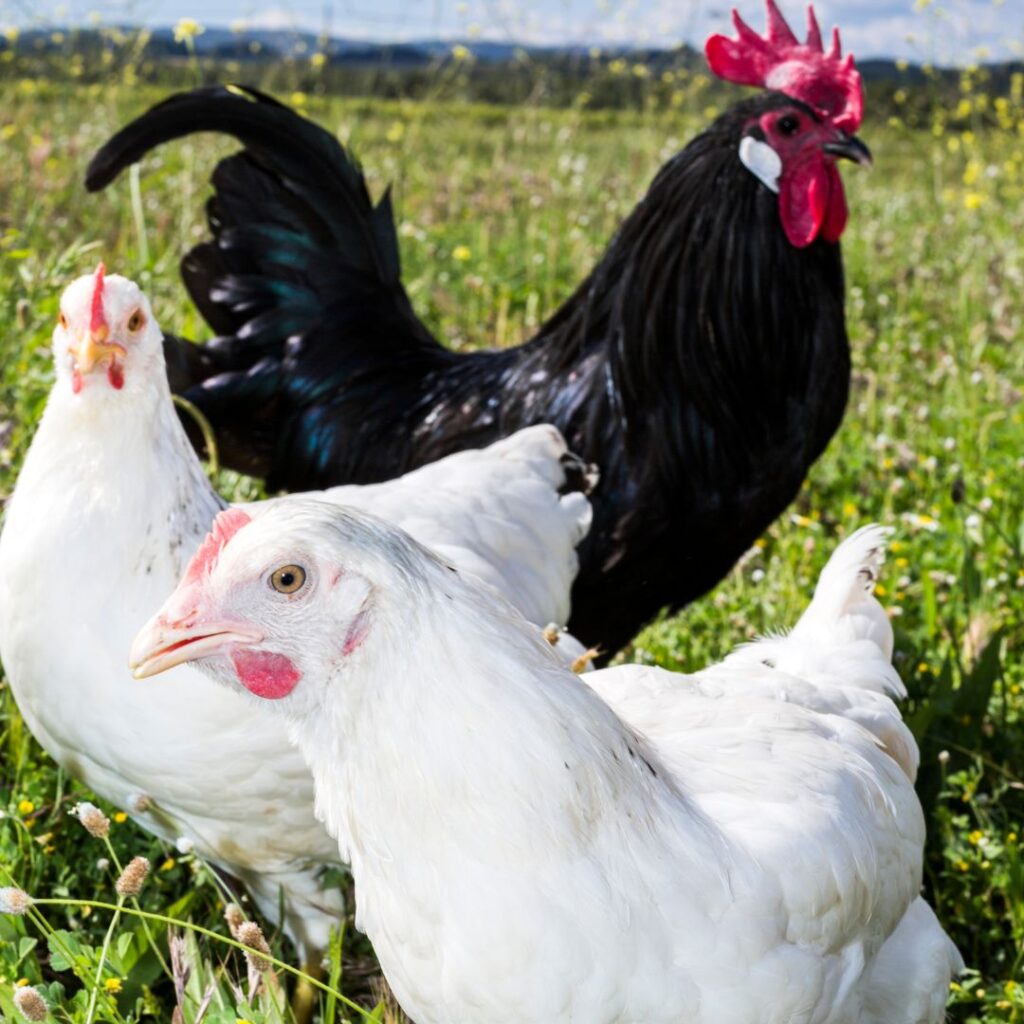
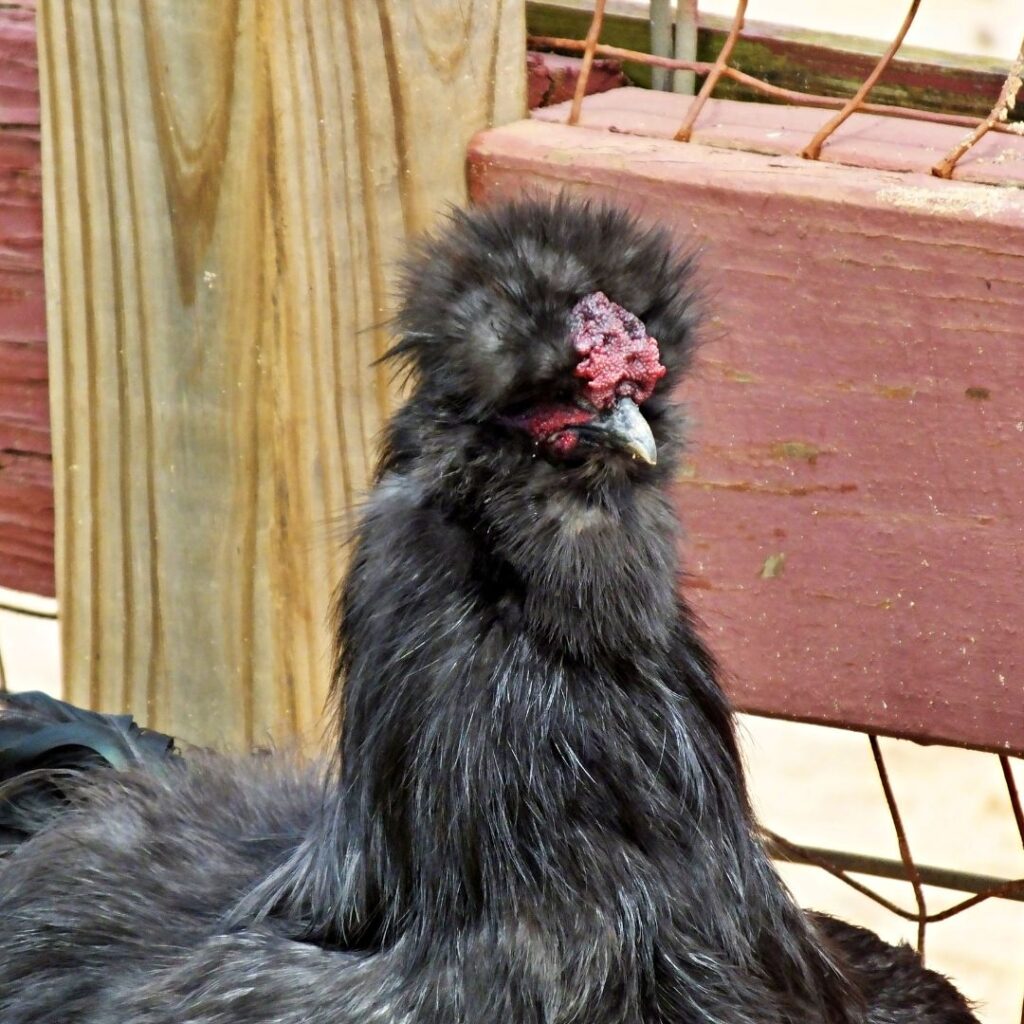
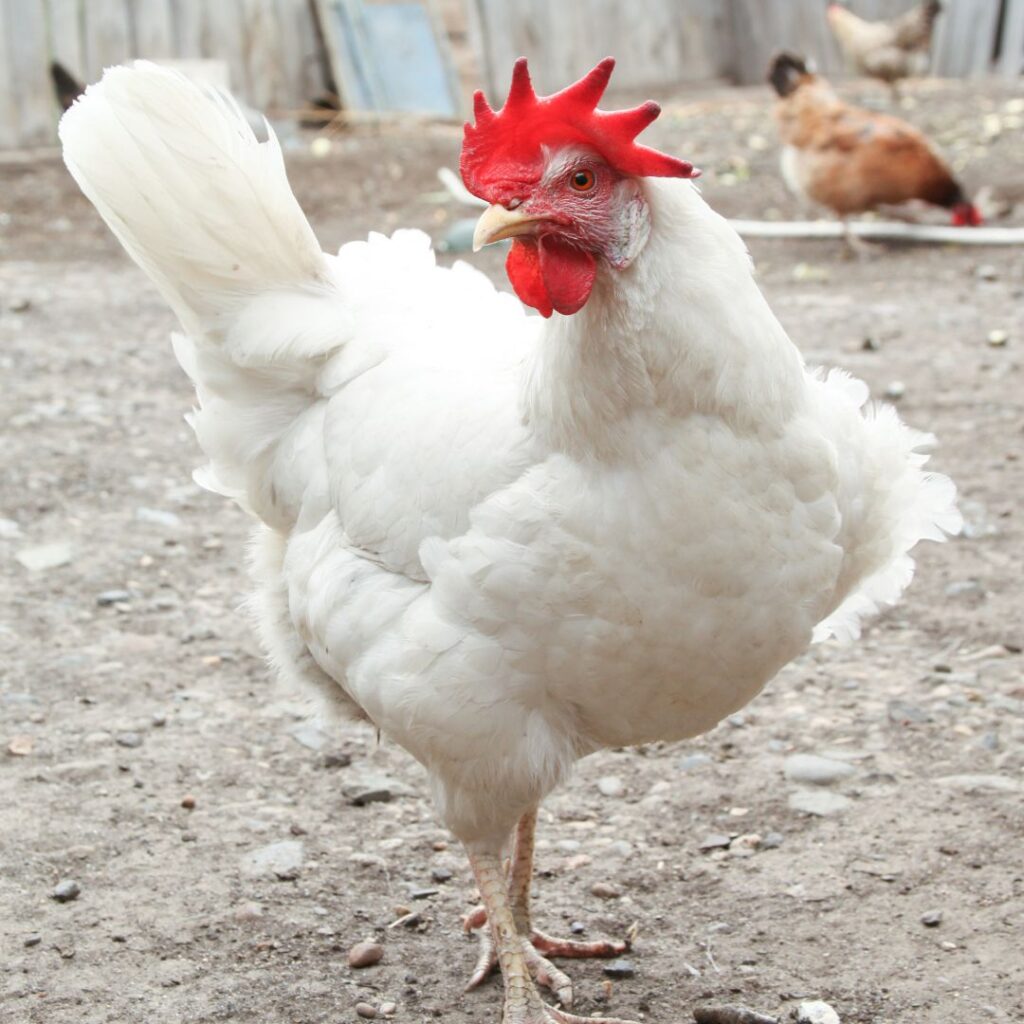
Pingback: 15+ Black Rooster Breeds And Hens - A Comprehensive Guide